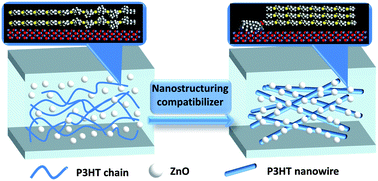The final device efficiencies of excitonic solar cells are strongly dependent on interface processes. However, it is still very challenging to clearly track the effects of inter-molecular processes at the mesoscopic level, while controlling the morphology and interface structure on the nanometer length scale. We report on the realization of a step-change improvement in poly(3-hexylthiophene)/ZnO-based hybrid solar cells, which is enabled by engineering the hybrid interface using a rod–coil diblock copolymer, poly(3-hexylthiophene)-b-poly(4-vinylpyridine) (P3HT-b-P4VP), as a nanostructuring compatibilizer in the P3HT/ZnO bulk heterojunctions. Upon evaporation of the solvent, the P3HT blocks of the copolymer cocrystallize with the homopolymer P3HT chains and phase separate from the ZnO domains, resulting in the P4VP blocks sitting at the edge of crystalline P3HT microdomains, or in other words, at the interfacial region between the P3HT and ZnO domains. P3HT-b-P4VP could enhance the crystallinity of P3HT and help spontaneously assemble P3HT into nanowires, while at the same time impeding the macrophase separation of the ZnO nanoparticles by taking advantage of the coordination interaction between the P4VP block and the ZnO nanoparticles, bridging the ZnO nanoparticles and the P3HT nanowires, thereby effectively improving the power-conversion efficiency. We show that a suitable nanostructuring compatibilizer induces selective intermolecular interactions, thus creating a preferential interface energetic landscape and morphological order, which consequently drive a strong improvement in the exciton dissociation and charge transport by decreasing recombination losses.

You have access to this article
 Please wait while we load your content...
Something went wrong. Try again?
Please wait while we load your content...
Something went wrong. Try again?


 Please wait while we load your content...
Please wait while we load your content...